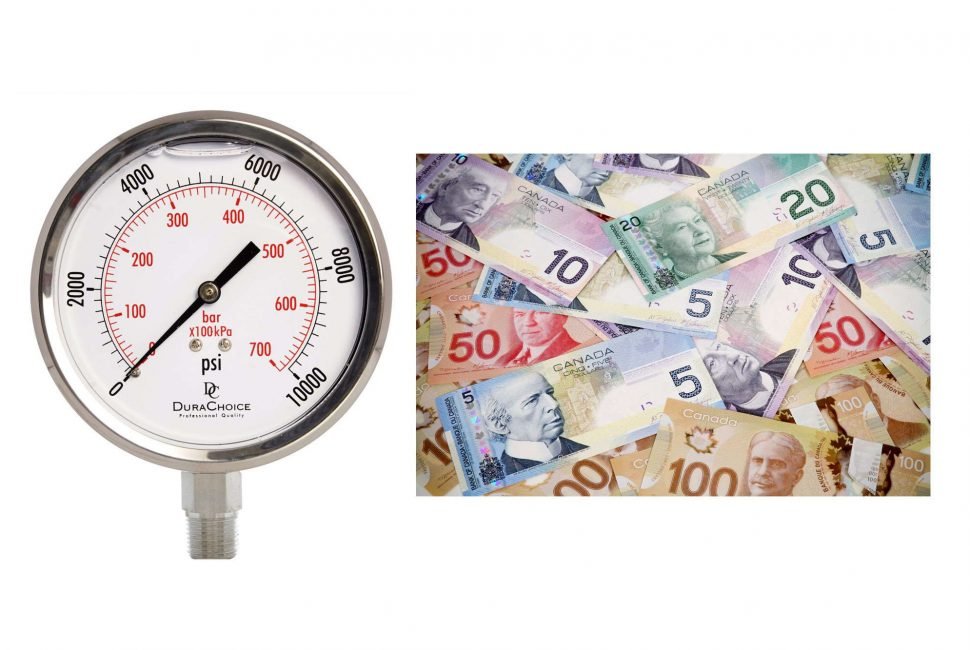Is compressed air pressure putting pressure on your bottom line?

We already know by now that compressed air systems while critical to our manufacturing processes are notoriously inefficient by most standards. Up to 90% of the input energy to a compressor is rejected as heat; which leaves us a potential for 10% of that input energy to do the actual work of compressed air, of that we’ve sadly accepted that 30% of that will be lost to leaks and of the remaining 7% we’ll lose some to bad applications and we’ll lose some more to pressure loss in piping and across filters and dryers.
So how does pressure affect the cost of a compressed air system and what are our strategies to manage pressure so that it doesn’t manage us?
Why is pressure important? Pressure is one of the primary variables for determining how compressed air does work. Force = Area x Pressure and so in any compressed air application where force is required the pressure becomes critical to achieving the correct force, whether it be pushing, pulling, opening, closing, lifting punching or stamping if you change the pressure you change the force. We therefore determine the pressure we need in a system so that we allow for the force the job requires given the available type of “area” being a linear or rotary actuator for example. If we supply too low a pressure then we do not create enough force to do our job. Many production machines have low pressure alarms that will shut machines down when the pressure falls below the minimum threshold for operation, many processes suffer from poor repeatability due to fluctuating pressure, we just helped a client who was having one in every five parts rejected in quality control because of a pressure loss fluctuation during the cycling of his machine – he had never considered compressed air pressure being the issue. He told us he had plenty of pressure, and he did, he had purchased a new air compressor that could operate at 150 psig, his application required only 80 psig. This machine was a long way away from the compressor however and for convenience he made some new piping that was undersized, “it doesn’t matter” he said, “look at my gauge it says I have a 150 psig” We suggested he run the machine for us and that we all watch that pressure gauge whereupon we noticed the indicator on the gauge plummeting in pressure with each machine cycle, given our understanding of F=A x P we asked him how a reduction in force would affect his machine process. This client changed the piping to the machine for a few hundred dollars and told us we were saving him tens of thousands in rejected materials and customer complaints. In this case pressure or the lack of it where needed had a direct negative impact on this clients bottom line.
But….
This was not the only impact it had on his bottom line. His decision to buy a 150-psig compressor to supply 80 psig also had the following bottom line cost consequences. When considering below that our industry uses a standard that says every 2-psig = 1% of the energy cost in pressure generation.
Leaks – yes, the system did have leaks and those leaks at 150 psig; which puts the leak rate at 61% greater than it would have been by supplying the system with 90 psig. Using the flow through an orifice calculation that flow through a ¼ inch orifice at 150 psig is 195 SCFM while at 90 psig is 94.8 SCFM
Compressor Output – this client had a 50 horsepower air compressor with an output of 170 SCFM at a 150 psig, had he purchased a 100 psig variant of the exact same air compressor he would have had 200 SCFM available a 15% improvement in capacity or a 15% reduction in requirement. In order to create that 30 SCFM for an application we would have to provide a 10 horsepower compressor.
These are but a few examples of how pressure, too much or too little can have a direct impact on your bottom line. For our client his real bottom line pain came by way of poor quality control by lack of stable pressure at his process it cost him many times the cost of his compressed air system and was solved by a simple piping retrofit. This was the happy end result of a compressed air systems audit where we chasing down those pesky leaks!


